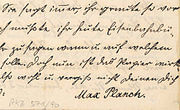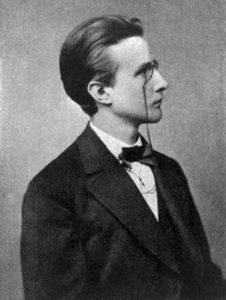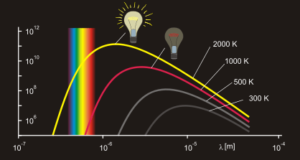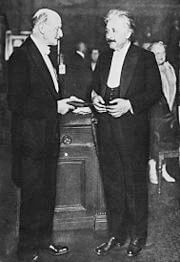Max Planck Introduces Quantum Mechanics
Max Planck (April 23, 1858 – October 4, 1947) was a German physicist. He is considered to be the founder of the quantum theory, and thus one of the most important physicists of the twentieth century. Planck was awarded the Nobel Prize in Physics in 1918.
Biography

Planck was born in Kiel, Holstein, to Johann Julius Wilhelm Planck and his second wife, Emma Patzig. He was baptised with the name of Karl Ernst Ludwig Marx Planck; of his given names,Marx (a now obsolete variant of Markus or maybe simply an error for Max, which is actually short for Maximilian) was indicated as the primary name. However, by the age of ten he signed with the name Max and used this for the rest of his life.Planck came from a traditional, intellectual family. His paternal great-grandfather and grandfather were both theology professors in Göttingen, his father was a law professor in Kiel and Munich, and his paternal uncle was a judge.
He was the sixth child in the family, though two of his siblings were from his father’s first marriage. Among his earliest memories was the marching of Prussian and Austrian troops into Kiel during the Danish-Prussian war of 1864. In 1867 the family moved to Munich, and Planck enrolled in the Maximilians gymnasium school, where he came under the tutelage of Hermann Müller, a mathematician who took an interest in the youth, and taught him astronomy and mechanics as well as mathematics. It was from Müller that Planck first learned the principle of conservation of energy. Planck graduated early, at age 17. This is how Planck first came in contact with the field of physics.

The Munich physics professor Philipp von Jolly advised Planck against going into physics, saying, “in this field, almost everything is already discovered, and all that remains is to fill a few holes.” Planck replied that he did not wish to discover new things, only to understand the known fundamentals of the field, and began his studies in 1874 at the University of Munich. Under Jolly’s supervision, Planck performed the only experiments of his scientific career, studying the diffusion of hydrogen through heated platinum, but transferred to theoretical physics.Planck was gifted when it came to music. He took singing lessons and played piano, organ and cello, and composed songs and operas. However, instead of music he chose to study physics.
In 1877 he went to Berlin for a year of study with physicists Hermann von Helmholtz and Gustav Kirchhoff and the mathematician Karl Weierstrass. He wrote that Helmholtz was never quite prepared, spoke slowly, miscalculated endlessly, and bored his listeners, while Kirchhoff spoke in carefully prepared lectures which were dry and monotonous. He soon became close friends with Helmholtz. While there he undertook a program of mostly self-study of Clausius’s writings, which led him to choose heat theory as his field.
In October 1878, Planck passed his qualifying exams and in February 1879 defended his dissertation, Über den zweiten Hauptsatz der mechanischen Wärmetheorie (On the second fundamental theorem of the mechanical theory of heat). He briefly taught mathematics and physics at his former school in Munich.
In June 1880 he presented his habilitation thesis, Gleichgewichtszustände isotroper Körper in verschiedenen Temperaturen (Equilibrium states of isotropic bodies at different temperatures).
Academic Career
With the completion of his habilitation thesis, Planck became an unpaid private lecturer in Munich, waiting until he was offered an academic position. Although he was initially ignored by the academic community, he furthered his work on the field of heat theory and discovered one after another the same thermodynamical formalism as Gibbs without realizing it. Clausius’s ideas on entropy occupied a central role in his work.
In April 1885 the University of Kiel appointed Planck as associate professor of theoretical physics. Further work on entropy and its treatment, especially as applied in physical chemistry, followed. He proposed a thermodynamic basis for Svante Arrhenius’s theory of electrolytic dissociation.
Within four years he was named the successor to Kirchhoff’s position at the University of Berlin — presumably thanks to Helmholtz’s intercession — and by 1892 became a full professor. In 1907 Planck was offered Boltzmann’s position in Vienna, but turned it down to stay in Berlin. During 1909, as University of Berlin professor, eight of his lectures were used by the Ernest Kempton Adams Fund for Physical Research in Theoretical Physics at Columbia University in New York City for a series of lectures translated by Columbia University professor A. P. Wills. He retired from Berlin on January 10, 1926, and was succeeded by Erwin Schrödinger.
Family
In March 1887 Planck married Marie Merck (1861-1909), sister of a school fellow, and moved with her into a sublet apartment in Kiel. They had four children: Karl (1888-1916), the twins Emma (1889-1919) and Grete (1889-1917), and Erwin (1893-1945).
After the appointment to Berlin, the Planck family lived in a villa in Berlin-Grunewald, Wangenheimstraße 21. Several other professors of Berlin University lived nearby, among them theologian Adolf von Harnack, who became a close friend of Planck. Soon the Planck home became a social and cultural centre. Numerous well-known scientists, such as Albert Einstein, Otto Hahn and Lise Meitner were frequent visitors. The tradition of jointly performing music had already been established in the home of Helmholtz.
After several happy years the Planck family was struck by a series of disasters. In July 1909 Marie Planck died, possibly from tuberculosis. In March 1911 Planck married his second wife, Marga von Hoesslin (1882-1948); in December his third son Hermann was born.
During the First World War Planck’s second son Erwin was taken prisoner by the French in 1914, while his oldest son Karl was killed in action at Verdun. Grete died in 1917 while giving birth to her first child. Her sister died the same way two years later, after having married Grete’s widower. Both granddaughters survived and were named after their mothers. Planck endured these losses stoically.
In January 1945, Erwin, to whom he had been particularly close, was sentenced to death by the Nazi Volksgerichtshof because of his participation in the failed attempt to assassinate Hitler in July 1944. Erwin was executed on 23 January 1945.
- Wives: Marie Merck (m. 1887), Marga von Hoesslin (m. 1910)
- Children: Karl (1888-1916), twins Emma (1889-1919) and Grete (1889-1917), Erwin (1893-1945), Hermann (b. 1911)
Professor at Berlin University
In Berlin, Planck joined the local Physical Society. He later wrote about this time: “In those days I was essentially the only theoretical physicist there, whence things were not so easy for me, because I started mentioning entropy, but this was not quite fashionable, since it was regarded as a mathematical spook”. Thanks to his initiative, the various local Physical Societies of Germany merged in 1898 to form the German Physical Society (Deutsche Physikalische Gesellschaft, DPG); from 1905 to 1909 Planck was the president.
Planck started a six-semester course of lectures on theoretical physics, “dry, somewhat impersonal” according to Lise Meitner, “using no notes, never making mistakes, never faltering; the best lecturer I ever heard” according to an English participant, James R. Partington, who continues: “There were always many standing around the room. As the lecture-room was well heated and rather close, some of the listeners would from time to time drop to the floor, but this did not disturb the lecture”. Planck did not establish an actual “school”; the number of his graduate students was only about 20, among them:
1897 Max Abraham (1875 – 1922)
1904 Moritz Schlick (1882 – 1936)
1906 Walther Meißner (1882 – 1974)
1906 Max von Laue (1879 – 1960)
1907 Fritz Reiche (1883 – 1960)
1912 Walter Schottky (1886 – 1976)
1914 Walther Bothe (1891 – 1957)
Black Body Radiation

Planck’s first proposed solution to the problem in 1899 followed from what Planck called the “principle of elementary disorder”, which allowed him to derive Wien’s law from a number of assumptions about the entropy of an ideal oscillator, creating what was referred-to as the Wien-Planck law. Soon it was found that experimental evidence did not confirm the new law at all, to Planck’s frustration. Planck revised his approach, deriving the first version of the famous Planck black-body radiation law, which described the experimentally observed black-body spectrum well. It was first proposed in a meeting of the DPG on October 19, 1900 and published in 1901. This first derivation did not include energy quantisation, and did not use statistical mechanics, to which he held an aversion. In November 1900, Planck revised this first approach, relying on Boltzmann’s statistical interpretation of the second law of thermodynamics as a way of gaining a more fundamental understanding of the principles behind his radiation law. As Planck was deeply suspicious of the philosophical and physical implications of such an interpretation of Boltzmann’s approach, his recourse to them was, as he later put it, “an act of despair … I was ready to sacrifice any of my previous convictions about physics.”In 1894 Planck turned his attention to the problem of black-body radiation. He had been commissioned by electric companies to create maximum light from lightbulbs with minimum energy. The problem had been stated by Kirchhoff in 1859: how does the intensity of the electromagnetic radiation emitted by a black body (a perfect absorber, also known as a cavity radiator) depend on the frequency of the radiation (e.g., the color of the light) and the temperature of the body? The question had been explored experimentally, but no theoretical treatment agreed with experimental values. Wilhelm Wien proposed Wien’s law, which correctly predicted the behaviour at high frequencies, but failed at low frequencies. The Rayleigh-Jeans law, another approach to the problem, created what was later known as the “ultraviolet catastrophe”, but contrary to many textbooks this was not a motivation for Planck.
The central assumption behind his new derivation, presented to the DPG on 14 December 1900, was the supposition, now known as the Planck postulate, that electromagnetic energy could be emitted only in quantized form, in other words, the energy could only be a multiple of an elementary unit E = hν, where h is Planck’s constant, also known as Planck’s action quantum (introduced already in 1899), and ν is the frequency of the radiation.
At first Planck considered that quantisation was only “a purely formal assumption … actually I did not think much about it…”; nowadays this assumption, incompatible with classical physics, is regarded as the birth of quantum physics and the greatest intellectual accomplishment of Planck’s career (Ludwig Boltzmann had been discussing in a theoretical paper in 1877 the possibility that the energy states of a physical system could be discrete). Further interpretation of the implications of Planck’s work was advanced by Albert Einstein in 1905 in connection with his work on the photoelectric effect—for this reason, the philosopher and historian of science Thomas Kuhn argued that Einstein should be given credit for quantum theory more so than Planck, since Planck did not understand in a deep sense that he was “introducing the quantum” as a real physical entity, Be that as it may, it was in recognition of Planck’s monumental accomplishment that he was awarded the Nobel Prize in Physics in 1918.
The discovery of Planck’s constant enabled him to define a new universal set of physical units (such as the Planck length and the Planck mass), all based on fundamental physical constants.
Subsequently, Planck tried to grasp the meaning of energy quanta, but to no avail. “My unavailing attempts to somehow reintegrate the action quantum into classical theory extended over several years and caused me much trouble.” Even several years later, other physicists like Rayleigh, Jeans, and Lorentz set Planck’s constant to zero in order to align with classical physics, but Planck knew well that this constant had a precise nonzero value. “I am unable to understand Jeans’ stubbornness — he is an example of a theoretician as should never be existing, the same as Hegel was for philosophy. So much the worse for the facts, if they are wrong.”
Max Born wrote about Planck: “He was by nature and by the tradition of his family conservative, averse to revolutionary novelties and skeptical towards speculations. But his belief in the imperative power of logical thinking based on facts was so strong that he did not hesitate to express a claim contradicting to all tradition, because he had convinced himself that no other resort was possible.”
Einstein and The Theory of Relativity

Einstein’s hypothesis of light quanta (photons), based on Philipp Lenard’s 1902 discovery of the photoelectric effect, was initially rejected by Planck. He was unwilling to discard completely Maxwell’s theory of electrodynamics. “The theory of light would be thrown back not by decades, but by centuries, into the age when Christian Huygens dared to fight against the mighty emission theory of Isaac Newton …”In 1905 the three epochal papers of the hitherto completely unknown Albert Einstein were published in the journal Annalen der Physik. Planck was among the few who immediately recognized the significance of the special theory of relativity. Thanks to his influence this theory was soon widely accepted in Germany. Planck also contributed considerably to extend the special theory of relativity.
In 1910 Einstein pointed out the anomalous behavior of specific heat at low temperatures as another example of a phenomenon which defies explanation by classical physics. Planck and Nernst, seeking to clarify the increasing number of contradictions, organized the First Solvay Conference (Brussels 1911). At this meeting Einstein was able to convince Planck.
Meanwhile Planck had been appointed dean of Berlin University, whereby it was possible for him to call Einstein to Berlin and establish a new professorship for him (1914). Soon the two scientists became close friends and met frequently to play music together.
World War and Weimar Republic
At the onset of the First World War Planck was not immune to the general excitement of the public: “… besides of much horrible also much unexpectedly great and beautiful: the swift solution of the most difficult issues of domestic policy through arrangement of all parties… the higher esteem for all that is brave and truthful…” Admittedly, he refrained from the extremes of nationalism. He voted successfully for a scientific paper from Italy receiving a prize from the Prussian Academy of Sciences in 1915 (Planck was one of its four permanent presidents), although at that time Italy was about to join the Allies. The infamous “Manifesto of the 93 intellectuals”, a polemic pamphlet of war propaganda, was also signed by Planck, while Einstein retained a strictly pacifistic attitude which almost led to his imprisonment (he was saved by his Swiss citizenship). But in 1915 Planck revoked (after several meetings with Dutch physicist Lorentz) parts of the Manifesto, and in 1916 he signed a declaration against German annexationism.
In the turbulent post-war years, Planck, now the highest authority of German physics, issued the slogan “persevere and continue working” to his colleagues. In October 1920 he and Fritz Haber established theNotgemeinschaft der Deutschen Wissenschaft (Emergency Organization of German Science), aimed at providing support for destitute scientific research. A considerable portion of the monies they distributed were raised abroad. In this time Planck held leading positions also at Berlin University, the Prussian Academy of Sciences, the German Physical Society and the Kaiser-Wilhelm-Gesellschaft (which in 1948 became the Max-Planck-Gesellschaft). Under such conditions he was hardly able to conduct research.
He became a member of the Deutsche Volks-Partei (German People’s Party), the party of Nobel Peace Prize laureate Gustav Stresemann, which aspired to liberal aims for domestic policy and rather revisionistic aims for international politics. He disagreed with the introduction of universal suffrage and later expressed the view that the Nazi dictatorship resulted from “the ascent of the rule of the crowds”.
Quantum Mechanics
At the end of the 1920s Bohr, Heisenberg and Pauli had worked out the Copenhagen interpretation of quantum mechanics, but it was rejected by Planck, as well as Schrödinger, Laue, and Einstein. Planck expected that wave mechanics would soon render quantum theory—his own child—unnecessary. This was not to be the case, however. Further work only cemented quantum theory, even against his and Einstein’s philosophical revulsions. Planck experienced the truth of his own earlier observation from his struggle with the older views in his younger years: “A new scientific truth does not triumph by convincing its opponents and making them see the light, but rather because its opponents eventually die, and a new generation grows up that is familiar with it.”
Nazi Dictatorship and The Second World War
When the Nazis seized power in 1933, Planck was 74. He witnessed many Jewish friends and colleagues expelled from their positions and humiliated, and hundreds of scientists emigrated from Germany. Again he tried the “persevere and continue working” slogan and asked scientists who were considering emigration to remain in Germany. He hoped the crisis would abate soon and the political situation would improve. There was also a deeper argument against emigration. Emigrating German non-Jewish scientists would need to look for academic positions abroad, but these positions better served Jewish scientists, who had no chance of continuing to work in Germany.
Hahn asked Planck to gather well-known German professors in order to issue a public proclamation against the treatment of Jewish professors, but Planck replied, “If you are able to gather today 30 such gentlemen, then tomorrow 150 others will come and speak against it, because they are eager to take over the positions of the others.” Under Planck’s leadership, the Kaiser-Wilhelm-Gesellschaft (KWG) avoided open conflict with the Nazi regime, except concerning Fritz Haber. Planck tried to discuss the issue with Adolf Hitler but was unsuccessful. In the following year, 1934, Haber died in exile.
One year later, Planck, having been the president of the KWG since 1930, organized in a somewhat provocative style an official commemorative meeting for Haber. He also succeeded in secretly enabling a number of Jewish scientists to continue working in institutes of the KWG for several years. In 1936, his term as president of the KWG ended, and the Nazi government pressured him to refrain from seeking another term.
As the political climate in Germany gradually became more hostile, Johannes Stark, prominent exponent of Deutsche Physik (“German Physics”, also called “Aryan Physics”) attacked Planck, Sommerfeld and Heisenberg for continuing to teach the theories of Einstein, calling them “white Jews.” The “Hauptamt Wissenschaft” (Nazi government office for science) started an investigation of Planck’s ancestry, but all they could find out was that he was “1/16 Jewish.”
In 1938 Planck celebrated his 80th birthday. The DPG held a celebration, during which the Max-Planck medal (founded as the highest medal by the DPG in 1928) was awarded to French physicist Louis de Broglie. At the end of 1938 the Prussian Academy lost its remaining independence and was taken over by Nazis (Gleichschaltung). Planck protested by resigning his presidency. He continued to travel frequently, giving numerous public talks, such as his talk on Religion and Science, and five years later he was sufficiently fit to climb 3,000-meter peaks in the Alps.
During the Second World War, the increasing number of Allied bombing campaigns against Berlin forced Planck and his wife to leave the city temporarily and live in the countryside. In 1942 he wrote: “In me an ardent desire has grown to persevere this crisis and live long enough to be able to witness the turning point, the beginning of a new rise.” In February 1944 his home in Berlin was completely destroyed by an air raid, annihilating all his scientific records and correspondence. Finally, he got into a dangerous situation in his rural retreat because of the rapid advance of the Allied armies from both sides. After the end of the war he was brought to a relative in Göttingen.
Planck endured many personal tragedies after the age of 50. In 1909, his first wife died after 22 years of marriage, leaving him with two sons and twin daughters. Planck’s oldest son, Karl, was killed in action in 1916. His daughter Margarete died in childbirth in 1917, and another daughter, Emma, married her late sister’s husband and then also died in childbirth, in 1919. During World War II, Planck’s house in Berlin was completely destroyed by bombs in 1944 and his youngest son, Erwin, was implicated in the attempt made on Hitler’s life in the July 20 plot. Consequently, Erwin died at the hands of the Gestapo in 1945. Although it is said that Erwin could have been spared had Planck joined the Nazi Party, Planck took a stand and refused to join, and as a consequence Erwin was executed. Erwin’s death destroyed Planck’s will to live. By the end of the war, Planck, his second wife and his son by her, moved to Göttingen where he died on October 4, 1947.
Religious Views
Planck was a devoted and persistent adherent of Christianity from early life to death, but he was very tolerant towards alternative views and religions, and so was discontented with the Nazi church organizations’ demands for unquestioning belief.
The God in which Planck believed was an almighty, all-knowing, benevolent but unintelligible God that permeated everything, manifest by symbols, including physical laws. His view may have been motivated by an opposition like Einstein’s and Schrödinger’s against the positivist, statistical subjective quantum mechanics universe of Bohr, Heisenberg and others. Planck was interested in truth and Universe beyond observation, and objected to atheism as an obsession with symbols.
Planck regarded the scientist as a man of imagination and faith, “faith” interpreted as being similar to “having a working hypothesis”. For example the causality principle isn’t true or false, it is an act of faith. Thereby Planck may have indicated a view that points toward Imre Lakatos’ research programs process descriptions, where falsification is mostly tolerable, in faith of its future removal.
Honors and Awards

- Nobel Prize in Physics 1918 (awarded 1919)
- Lorentz Medal 1927
- Adlerschild des Deutschen Reiches (1928), an award from the German Reich President
- Max Planck medal (1929, together with Einstein)
- Copley Medal (1929)
- Planck received honorary doctorates from the universities of Frankfurt, Munich (TH), Rostock, Berlin (TH), Graz, Athens, Cambridge, London, and Glasgow.
- The asteroid 1069 was named “Stella Planckia” by the Inter
1900 B.C. Max Planck Introuduces Quantum Mechanics

Based on data, it seems that Max Planck understood from the beginning that his theory was good, but he was blocked by the fact that imagination does not workQuantum Mechanics is the first purely symbolic model associated to external reality. Such a model is “pure”, because it cannot be translated or associated with any image model. This is a very high step in the evolution of the brain (level 5 of evolution),in understanding it. It seems that Albert Einstein pushed him to publish the theory.
Quantum Mechanics cannot be translated to image models. If someone forces such a translation, aberations or logical contradictions occur. The best known
problem is the nature of light. Quantum Mechanics predicts that light is both wave and particle. This situation cannot be understood based on image models.
Quantum Mechanics pushed forward the evolution of society on a very high technological level (e.g. the transistors and the lasers are the basic components to build computers).
For more information please call us: 1-409-861-0788 or toll-free at 1-866-861-0788.

